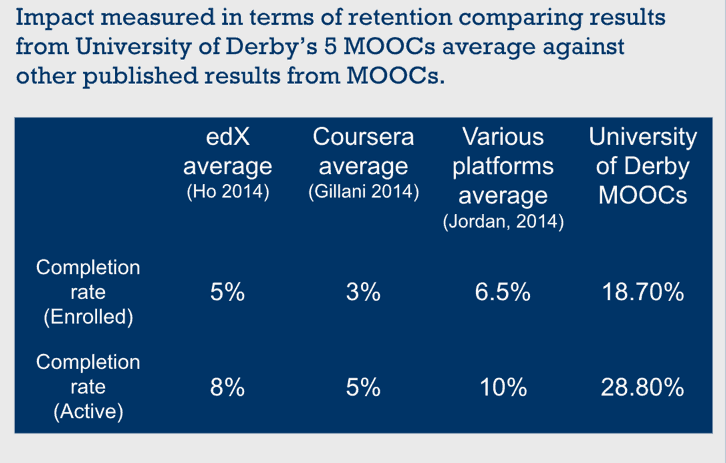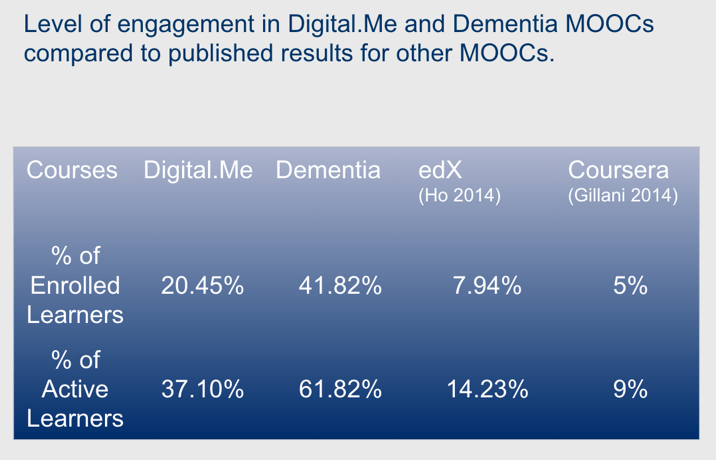MOOCS – How to Make Money and Increase Influence (without Charging Learners)
Three key takeaways derived from the University of Derby’s successful track record of creating MOOCs.
Editor’s note: This is a guest post by Hilary Melander, Manager of Canvas Network, Instructure’s MOOC platform.
In early 2016 Munib Hadi, Head of Academic Innovation Hub at the University of Derby, was extended the challenge of developing a MOOC strategy that is sustainable and open, and which provides relevant learning opportunities to learners.
In the end, the MOOCs from the university that are hosted on Canvas Network generated over £42,000 worth of marketing, the university saw an enrollment impact of over £1.15 million, and the team was invited to share their research and initiatives with government officials and multinational organizations. In all, their mission to develop a MOOC strategy that is sustainable, open, and impactful was accomplished.
But how did they do it?
Here are three lessons from Munib Hadi, Head of Academic Innovation Hub.
InstCon16 | Institutional Strategies and Business Benefits of running MOOCs
Lesson 1: Develop an Open Strategy
One of the most precious resources today is attention. The Innovation Hub team realized early on that if they wanted to be successful, their courses needed to present real and relevant learning experiences to learners. Furthermore, to push innovation further, the policies that guided MOOC development needed to stay true to openness in education. To achieve these objectives, Munib and his team at the Innovation Hub decided to adopt the policies under the MOOC quality label called OpenUpEd.
OpenUpEd is a MOOC quality framework that puts the learner at the center. Here are its tenets:
- learner-centered,
- openness to learners,
- digital openness,
- independent learning,
- media-supported interaction,
- recognition options,
- focus on quality, and
- a spectrum of diversity.
The Innovation Hub further embraced their open strategy by sharing the MOOCs released under Creative Commons Licenses to Canvas Commons, a learning object repository.
The open strategy paid off for Innovation Hub. The high quality learning experiences created by the team showcased the excellent learning experience the university offers to its students. This prompted close to 1% of over 22,000 MOOCs learners to enroll in the university’s fee-based courses.
Another unforeseen benefit of using an open strategy to direct the team’s effort was that it showed government agencies and multinational organizations that MOOCs can be a valuable resource to upskill the workforce in key areas of skills shortages, both nationally and internationally.
Lesson 2: Actively Experiment with Pedagogy
MOOC learners are very different from students enrolling in traditional academic institutions. Traditional academic institutions attract a fairly homogeneous student body. MOOCs, in contrast, attract largely diverse learners who come from all over the world, have varying education levels, and come from different socio-economic backgrounds.
How do you design a course that can appeal to such a vast base of learners?
Innovation Hub’s team set out to test specific learning pedagogy with a focus on micro-learning, and the flexibility to share one’s learning path in the hands of learners. They referred to this approach as the Modular Approach. They were intentional with their course design and set out to test micro-learning and micro-credentials. These tests became increasingly important as some institutions rushed to measure MOOC success through course completion rates. (See Class Central’s blog post on the University of Derby and this research publication for more information.)
They also believed from the onset that the traditional methods of retention calculation are obsolete in the MOOC context due to the free and drop-in, dropout nature of some of these courses. A great number of learners who log on to MOOCs do learn but don’t have the time to complete a typical six-to-eight week course. Munib’s team developed tools and mechanisms around the MOOCs they produced. The tools had the aim of recording these micro-learning achievements, which they believed should be taken into account when gauging retention numbers for MOOCs.
The team also looked at how to provide structured guided learning experiences to potentially thousands of learners. They devised an automated and structured guided experience that left learners with the feeling that the course was particularly tailored for them. (See here for more information.)
Lesson 3: Conduct Market Research
Innovation Hub discovered that it is important to select the right course at the right time. This does require some market research before determining which courses to offer. In their market research, Innovation Hub specifically looked at relevance to the market, key national priority areas for skills shortage, and the university’s own academic strengths in subject area and public demand.
Summary of Benefits
| Area of Impact | Value of Impact |
| Enrollment | Over 22,000 learners enrolled in five MOOCs.
Around 1% of MOOC learners enrolled in fee-based courses (89% enrolled in face-to-face courses). Potential income of over £1.57 million in the first year (over 10x ROI). |
| Brand | £42,000 worth of marketing. |
| Reputation | Invitations to Westminster to demonstrate how MOOCs can be used to upscale people in a range of national priorities.
Invitations to discuss future collaborations with multinational organizations. |
| Pedagogy | Experimented with and researched micro-learning and micro-credentials with badges. |
| Business development | Developed the university CPD platform offering paid for and tailored training courses. |

Conclusion
If you believed the hype they generated in 2012, MOOCs were meant to transform higher education.
But within a year or two they were dismissed as a lousy product by one of their most affluent early adopters.
The fact is that both of these generalized statements miss the point. MOOCs can be a really innovative and sustainable tool for workforce development, if they are developed and run with a well thought out strategy. That starts with applying vigorous quality controls, like those that Higher Education institutions apply when developing formal qualifications. It also requires that the pedagogy be adapted to deliver to such a diverse and varied audience.
To learn more about the University of Derby’s Innovation Hub’s experience on Canvas Network, please view Munib’s presentation: Institutional Strategies and Business Benefits of Running MOOCs, which was shared at InstructureCon in July 2016.
About the author
Hilary Melander is the Manager of Canvas Network, Instructure’s MOOC platform. She has worked with hundreds of directors of online education, instructors, and instructional designers around the globe, with the goal of promoting openness and innovation in education.






